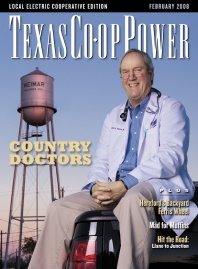Hooray for ‘Realistic Assessment’
I was happy to read your article “Energy Reality Check: Green Power” in the November issue of Texas Co-op Power. It was the first time that I have read a realistic assessment of the contributions that green power can make to our energy problems in a publication that is devoted to energy.
Most of what one reads about alternative energy resources in the newspapers and nature publications is of the feel-good variety, lacking real technical understanding and often expounding unrealistic and unachievable goals for future developments.
Take for instance wind energy. Your article lists the basic shortcomings of this development, the points you mention: variable wind or lack of wind; the fact that wind power capacity has to be backed up by conventional generating capacity (which in effect makes wind power installation wasteful); challenges for grid stability and grid management. The fact that these points are rarely mentioned is disingenuous, if not outright dishonest, because society has to pay these costs, which only profit the developers.
The minuscule contributions of wind energy become very obvious when one does some calculations based on real numbers.
Frits de Wette, Austin
Conventional Power Needed Now
We need major research and development efforts for our long-term energy needs, but we need to build additional conventional generating capacity now to avoid electric shortages that will damage our economy and limit our freedom to make the right choices.
William E. Sparks Jr., Coldspring, Sam Houston Electric Cooperative
Tired of Excuses
As I tried to implement a solar panel system for my house, I have learned that all the power generators in Texas, except for Austin Energy, do not really want to deal with small producers.
Texas power companies have no incentives to promote renewable energy. They give the excuse it will penalize those who do not install renewable power. They say renewable is not reliable. They say it costs too much. They say it is dangerous. Excuse, excuse, excuse.
Big power producers and distributors, when will you start to think beyond the status quo? Make an effort to extend our resources while promoting and creating new ones.
Mark J. Rasmussen, Forney, Farmers Electric Cooperative
Windmills Aren’t Eyesores
In regards to the use of wind and sun power, the belief that turbines would be an eyesore is an excuse. Remember how beautiful the lighthouses on the East Coast are and the windmills of the Dutch! I’m sure something could be done to enhance their appearance.
Patricia N. Terling, San Marcos, Bluebonnet Electric Cooperative
Plug-In Cars Long Way From Reality
Many things are possible, but batteries for plug-in electric cars are the weak link now. Gasoline and diesel are very powerful and easy to store and use. Hydrogen is possible and easy to use, but it is very hard to store in liquid form, and the pressures are high. I am not in the fuel business, but we need to be realistic about the possibilities. Some day there will be a breakthrough. I hope it is soon, but if you want to be able to drive away from the house, don’t be too hard on gasoline and diesel at this time.
Jim Bell, Quitman, Wood County Electric Cooperative
What About Net Metering?
There was no mention in your “Energy Reality Check” of net metering, a process where the co-op actually buys electricity from, as an example, a homeowner who installs solar or wind generation but can’t use all that he generates. I know Grayson-Collin Electric Co-op has approved net metering. Even though it is insignificant today, I see it as having huge potential.
In the section on solar, the article mentioned that “large amounts of it can’t be stored.” If enough people were able to generate their own electricity and sell it back to the co-op, wouldn’t the grid act like a pipeline storage that could be used to offset new electric generation?
Tony Manasseri, Grayson-Collin Electric Cooperative
Editor’s note: The grid can use solar and wind power only as it is produced. The grid cannot store electricity. Other kinds of power plants must provide electricity for times when the wind is not blowing and the sun is not shining. And conventional power plants can’t just be turned off when the renewables are available and on when they are not. It takes minutes to start a natural gas peaking plant and days to start a coal-fired plant.


